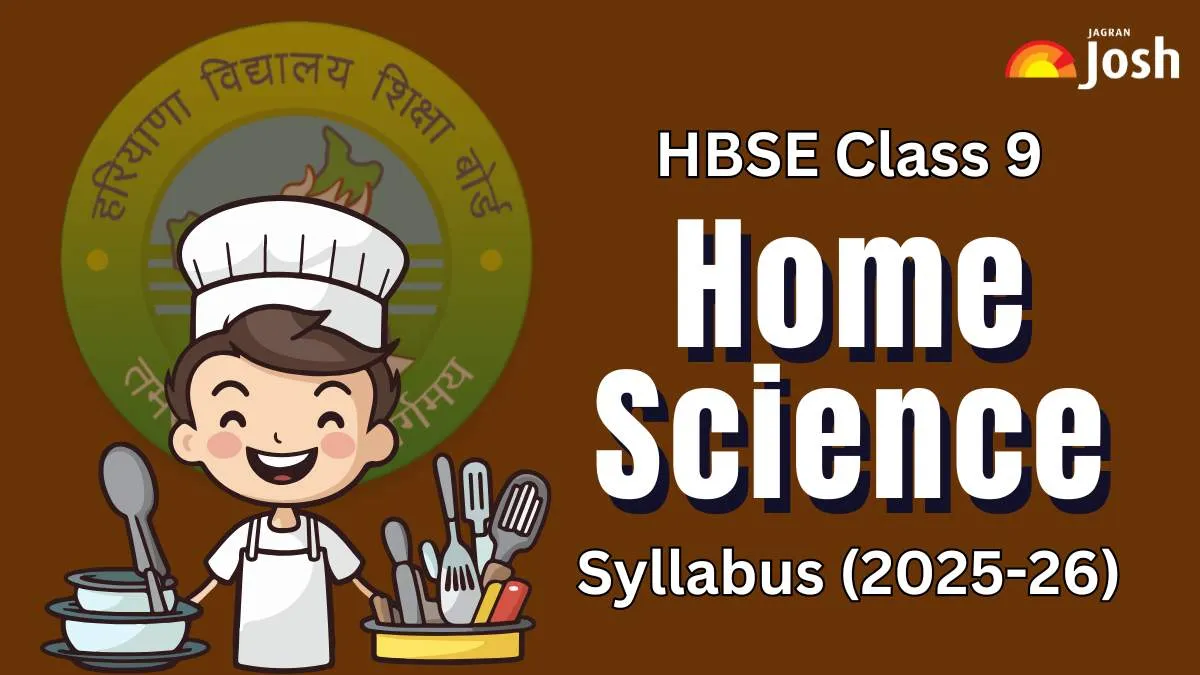HBSE Class 9 Home Science Syllabus 2025-26: The Haryana Board has released the syllabus for Home Science for the academic year 2025-26, on its official website – bseh.org.in. This syllabus serves as a comprehensive guide for students, outlining learning objectives, exam structure, and marking schemes. It is a crucial tool for academic planning, helping students understand key topics and prepare effectively for exams.
This article provides access to the latest HBSE Class 9 Home Science Syllabus for the 2025-26 academic year, including a downloadable PDF. It details the topics to be covered, mark distribution, exam patterns, and the overall course structure for the academic session. Students will also find instructions on how to download the Haryana Board Class 9 syllabus for 2025-26.
HBSE Class 9 Home Science Syllabus 2025-26: Course Structure
Find the Haryana Board Class 9th Home Science Syllabus 2025 course structure here. Students can check the Units and marks allocated to the particular unit for the Home Science syllabus:
Sr. No. | Units | Marks |
|---|---|---|
| 1 | Concept and scope of Home Science Education and recent trends | 04 |
| 2 | Human growth & Development – I | 07 |
| 3 | Family and Values | 07 |
| 4 | Food, Nutrition and Health | 13 |
| 5 | Fibre and Fabric | 13 |
| 6 | Resource Management | 11 |
| 7 | Measures of Safety and Management of Emergencies | 05 |
| Total | 60 | |
| Practical | 20 | |
| Internal Assessment | 20 | |
| Grand Total | 100 | |
HBSE Class 9 Home Science Syllabus 2025-26: Course Content
Find the Haryana Board Class 9th Home Science Syllabus 2025 Course Content.
Unit I: Concept and scope of Home Science Education and recent trends
a) Concept of Home Science
• evolution
• meaning
b) Fields of Home Science
• Food and nutrition
• Child development
• Clothing and textiles
• Human resource management
• Extension education and communication
c) Relevance of study of Home Science and career options
• Importance
• Career options in the field of home science
d) Recent trends
Unit II: Human Growth & Development– I
a) Concept of growth and development
• Meaning and definition
• Stages of life span
• Difference between growth and development
b) Principles of growth and development
c) Factors affecting growth and development (environmental and heredity)
• Environment
• Hereditary
• Birth order
• Child rearing practices
d) Age specific milestones (Birth to3 years)-Physical, motor, social, emotional, cognitive and language
• Physical
• Motor
• Social
• Emotional
• Cognitive
• language
Unit III: Family and Values
a) Concept and types of family
• Meaning and definition
• Characteristics of families
• Functions of families
• Types of families
b) Role of family in Holistic development of an individual
• Physical
• Social
• Psychological
• Spiritual
c) Ethical and value-based society
• need for happy family
• respect, and care for each member of the family
• Dignity of labour
• work distribution within the family
d) Importance of Girl Child
• Importance of girl child in family
• Government schemes for girl child
e) Influence of various factors on a family
• Globalisation
• Urbanisation
• Migration
• Technology and Media.
Unit IV: Food, Nutrition and Health
a) Definition of Food,
• Nutrition
• Nutrient
• Health
• Nutritional Status.
b) Food and its functions
• Physiological
• Social
• Psychological
c) Nutrients (sources and functions)
• Carbohydrates
• Proteins
• Fats
• Minerals
• Vitamins
d) Relationship between Food, Health, and Diseases
e) Malnutrition
• Concept
• components (over nutrition and under nutrition)
f) Concept of Balanced Diet
• Meaning of balanced diet
• Food groups
Unit V: Fibre and Fabric
a) Definitions of
• Fibre
• Yarn
• Fabric
• Apparel
b) Classification of fibre:
• On the basis of origin
• On the basis of length
c) Characteristics of fibres
• Introduction to fibres (cotton, silk, wool, polyester, rayon)
• Characteristics (feel, appearance, colour fastness, length, strength, absorbency, shrinkage, elasticity, effect of heat and sunlight)
Unit VI: Resource Management
a) Resources:
• Definition
• characteristics
b) Types of resources
• Human: Time, Energy, Knowledge and attitude
• Non-Human: Money, materialistic goods and community resources
c) Waste Management
• Concept
• Need to refuse, reduce, reuse, repair and recycle waste.
d) Proper disposal of kitchen waste
• Biodegradable: Composting, Vermicomposting, Biogas and Bagasse.
• Non-Biodegradable: Incineration, Landfills and Recycle
Unit VII: Measures of Safety and Management of Emergencies
a) Accident prone / Unsafe Zones at home
• Bathroom
• Electric appliances
• Ladders, stairs and elevators
• Kitchen
• chemicals
b) Need of safety at home
c) Measures of safety against:
• burns
• electric shocks
• cuts
• fractures
• bites
• poisoning
d) First Aid:
• Concept
• Importance
• First aid kit
To download complete HBSE Home Science class 9 syllabus for the academic year 2025-26. Students can click on the below mentioned link and download the full PDF for free.
Check:
HBSE Class 9 Home Science Syllabus 2025-26 Download PDF |
The HBSE Class 9 Home Science Syllabus for 2025-26 provides a clear roadmap for students preparing for their 2026 exams. The detailed syllabus helps in understanding the course structure, subject-wise weightage, and chapter-wise breakdown, facilitating a well-organized study plan and successful academic outcomes.

Comments
All Comments (0)
Join the conversation